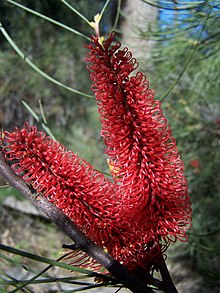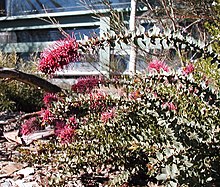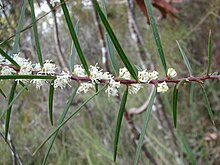Hakea
| Hakea | ||||||||||||
|---|---|---|---|---|---|---|---|---|---|---|---|---|

Ball-shaped pincushion ( Hakea laurina ) |
||||||||||||
| Systematics | ||||||||||||
|
||||||||||||
| Scientific name | ||||||||||||
| Hakea | ||||||||||||
| Schrad. & JCWendl. |
Hakea is a genus of plants withinthe silver tree family (Proteaceae). The common name pincushion is also used for some species. The 150or so species are found only in Australia and the greatest biodiversity can be found in southern Western Australia .
description
Hakea species grow as shrubs or smaller trees . The young twigs may be covered with two-armed trichomes . This hair is partly permanent, but it can also quickly become bald. The leaves are arranged in a spiral on the branch and are sessile, sometimes growing around the branch or with a tapering base that resembles a petiole. They are simple or composed, flat or round leaves, sometimes grooved lengthways with a serrated or entire leaf margin. Both leaf sides are designed similarly, the venature is distinct or unclear.
The inflorescences are in some species in a cone of bracts , they are usually axillary, rarely they arise from the older wood or are terminal. They are umbel-shaped grapes or short spindles with a few flowers, only rarely are there many-flowered inflorescences in long spindles. The stalked flowers are usually paired, straight or curved in the bud. The sepals are separated up to the base or are fused together and only separated at the tip. Under the ovary there is usually a semicircular or curved-lobed gland, which is rarely missing. The pistil is hairless, the bicameral ovary is stalked or almost sessile. The pollen presentation is upright, oblique or sideways, circular or conical with a narrow or wide edge.
The fruits are modified follicles , which can be lignified to different degrees, often beaked , sometimes horned, mostly jumping open with a delay. The flaps split the fruit completely or partially on one or two sides. The seeds take up the space of the entire valve or are slightly adjacent to one side, are flattened on one side and have a distal wing or wing that encircles the seed and clamps between the valves.
Systematics
The genus Hakea was established in 1797 by Heinrich Adolph Schrader and Johann Christoph Wendland in Sertum Hannoveranum , 27. Type species is Hakea glabra Schrad. & JCWendl., Today a synonym of Hakea teretifolia (Salisb.) Britten subsp. teretifolia . The generic name Hakea honors Baron Christian Ludewig von Hake , who as head of the Hanoverian Oberhofbau- und Gartendepartement was a supporter of science and in particular of the Herrenhausen Gardens .
There are around 150 Hakea species (German trivial names from Zander 2008):
- Hakea actites W.R.Barker : It is native to New South Wales and Queensland .
- Hakea aculeata A.S. George
- Hakea acuminata Haegi
- Hakea adnata R.Br.
- Hakea aenigma W.R.Barker & Haegi
- Hakea ambigua Meisn.
- Hakea amplexicaulis R.Br.
- Hakea anadenia Haegi
- Hakea arborescens R.Br.
- Hakea archaeoides W.R.Barker : It is only found in New South Wales.
- Hakea auriculata Meisn. & Kippist
- Hakea bakeriana F. Muell. & Maiden
- Hakea baxteri R.Br.
- Hakea bicornata R.M.Barker
- Hakea brachyptera Meisn.
- Hakea brownii Meisn.
- Prickly pincushion ( Hakea bucculenta C.A.Gardner )
- Hakea candolleana Meisn.
- Hakea carinata F. Muell. ex Meisn.
- Horn-leaved pincushion ( Hakea ceratophylla (Sm.) R.Br. )
- Hakea chordophylla F. Muell.
- Hakea cinerea R.Br.
- Hakea circumalata Meisn.
- Hakea clavata Labill.
- Hakea collina C.T. White
- Hakea commutata F. Muell.
- Hakea conchifolia Hook.
- Hakea constablei L.ASJohnson
- Hakea corymbosa R.Br.
- Hakea costata Meisn.
- Hakea cristata R.Br.
- Hakea cucullata R.Br.
- Horn-fruited pincushion ( Hakea cyclocarpa Lindl. )
- Hakea cycloptera R.Br.
- Hakea cygna Lamont
- Hand-shaped pincushion ( Hakea dactyloides (Gaertn.) Cav. )
- Hakea decurrens R.Br.
- Hakea denticulata R.Br.
- Hakea divaricata L.ASJohnson
- Hakea dohertyi Haegi
- Fragrant pincushion ( Hakea drupacea (CFGaertn.) Roem. & Schult. , Syn .: Hakea suaveolens R.Br. )
- Hakea ednieana Tate
- Hakea elliptica (Sm.) R.Br.
- Hakea eneabba Haegi
- Hakea epiglottis Labill.
- Hakea erecta Lamont
- Hakea eriantha R.Br.
- Hakea erinacea Meisn.
- Hakea eyreana (S.Moore) McGill.
- Hakea falcata R.Br.
- Rust-colored pincushion ( Hakea ferruginea Sweet )
- Hakea flabellifolia Meisn.
- Hakea florida R.Br.
- Hakea florulenta Meisn.
- Hakea francisiana F. Muell.
- Hakea fraseri R.Br.
- Hakea gibbosa (Sm.) Cav.
- Hakea gilbertii Kippist
- Hakea grammatophylla (F.Muell.) F.Muell.
- Hakea hastata Haegi
- Hakea hookeriana Meisn.
- Hakea horrida C.A. Gardner ex RMBarker
- Hakea ilicifolia R.Br.
- Hakea incrassata R.Br.
- Hakea invaginata B.L.Burtt
- Hakea ivoryi F.M.Bailey
- Hakea kippistiana Kippist & Meisn.
- Hakea laevipes Gand.
- Hakea lasiantha R.Br.
- Hakea lasianthoides Rye
- Hakea lasiocarpha R.Br.
- Ball-shaped pincushion ( Hakea laurina R.Br. )
- Hakea lehmanniana Meisn.
- Runners pincushion ( Hakea leucoptera R.Br. )
- Hakea linearis R.Br.
- Hakea lissocarpha R.Br.
- Hakea lissosperma R.Br.
- Hakea longiflora (Benth.) RMBarker
- Hakea loranthifolia Meisn.
- Hakea lorea (R.Br.) R.Br.
- Hakea maconochieana Haegi
- Hakea macraeana F. Muell.
- Hakea macrocarpa A. Cunn. ex R.Br.
- Hakea macrorrhyncha W.R.Barker
- Hakea marginata R.Br.
- Hakea megadenia R.M.Barker
- Hakea megalosperma Meisn.
- Hakea meisneriana Kippist
- Hakea microcarpa R.Br.
- Hakea minyma Maconochie
- Hakea mitchellii Meisn.
- Hakea multilineata Meisn.
- Hakea myrtoides Meisn.
- Hakea neurophylla Meisn.
- Hakea newbeyana R.M.Barker
- Knotty pincushion ( Hakea nitida R.Br. )
- Hakea nodosa R.Br.
- Hakea obliqua R.Br.
- Blunt pincushion ( Hakea obtusa Meisn. )
- Hakea ochroptera W.R.Barker
- Hakea oldfieldii Benth.
- Olive-leaved pincushion ( Hakea oleifolia (Sm.) R.Br. )
- Hakea oligoneura K.A. Sheph. & RMBarker
- Hakea orthorrhyncha F. Muell.
- Hakea pachyphylla Sieber ex Spreng.
- Hakea pandanicarpa R.Br.
- Hakea pedunculata F. Muell.
- Hakea pendens R.M.Barker
- Hakea persiehana F. Muell.
- Hakea petiolaris Meisn.
- Broad- seeded pincushion ( Hakea platysperma Hook. )
- Hakea plurinervia F. Muell. ex Benth.
- Hakea polyanthema Diels
- Hakea preissii Meisn.
- Hakea pritzelii Diels
- Hakea propinqua A. Cunn.
- Hakea prostrata R.Br.
- Hakea psilorrhyncha R.M.Barker
- Hakea pulvinifera L.ASJohnson
- Hakea purpurea hook.
- Hakea pycnoneura Meisn.
- Hakea recurva Meisn.
- Hakea repullulans H.M. Lee
- Hakea rhombales F.Muell.
- Hakea rigida C.A. Gardner ex Haegi
- Hakea rostrata F. Muell. ex Meisn.
- Hakea rugosa R.Br.
- Hakea ruscifolia Labill.
- Willow-leaved pin cushion ( Hakea salicifolia (Vent.) BLBurtt )
- Hakea scoparia Meisn.
- Needle- leaved pincushion ( Hakea sericea Schrad. & JCWendl. )
- Hakea smilacifolia Meisn.
- Hakea spathulata (Benth.) RMBarker
- Hakea standleyensis Maconochie
- Hakea stenocarpa R.Br.
- Hakea stenophylla A. Cunn. ex R.Br.
- Hakea strumosa Meisn.
- Hakea subsulcata Meisn.
- Hakea sulcata R.Br.
- Hakea tephrosperma R.Br.
- Hakea teretifolia (Salisb.) Britten
- Hakea trifurcata (Sm.) R.Br.
- Hakea trineura (F.Muell.) F.Muell.
- Hakea tuberculata R.Br.
- Hakea ulicina R.Br.
- Hakea undulata R.Br.
- Hakea varia R.Br.
- Hakea verrucosa F. Muell.
- Hakea victoria J. Drumm.
- Hakea vittata R.Br.
swell
Individual evidence
- ^ A b Walter Erhardt , Erich Götz, Nils Bödeker, Siegmund Seybold: The great pikeperch. Encyclopedia of Plant Names . Volume 2. Verlag Eugen Ulmer, Stuttgart 2008, ISBN 978-3-8001-5406-7 .
- ↑ a b c d R. M. Barker, L. Haegi, WR Barker: Hakea . In: ABRS Flora of Australia Online. last accessed on April 29, 2013.
- ↑ Hakea at Tropicos.org. Missouri Botanical Garden, St. Louis, accessed April 29, 2013.
- ↑ Entry at GRIN.
- ↑ List of names applied to Hakea species












